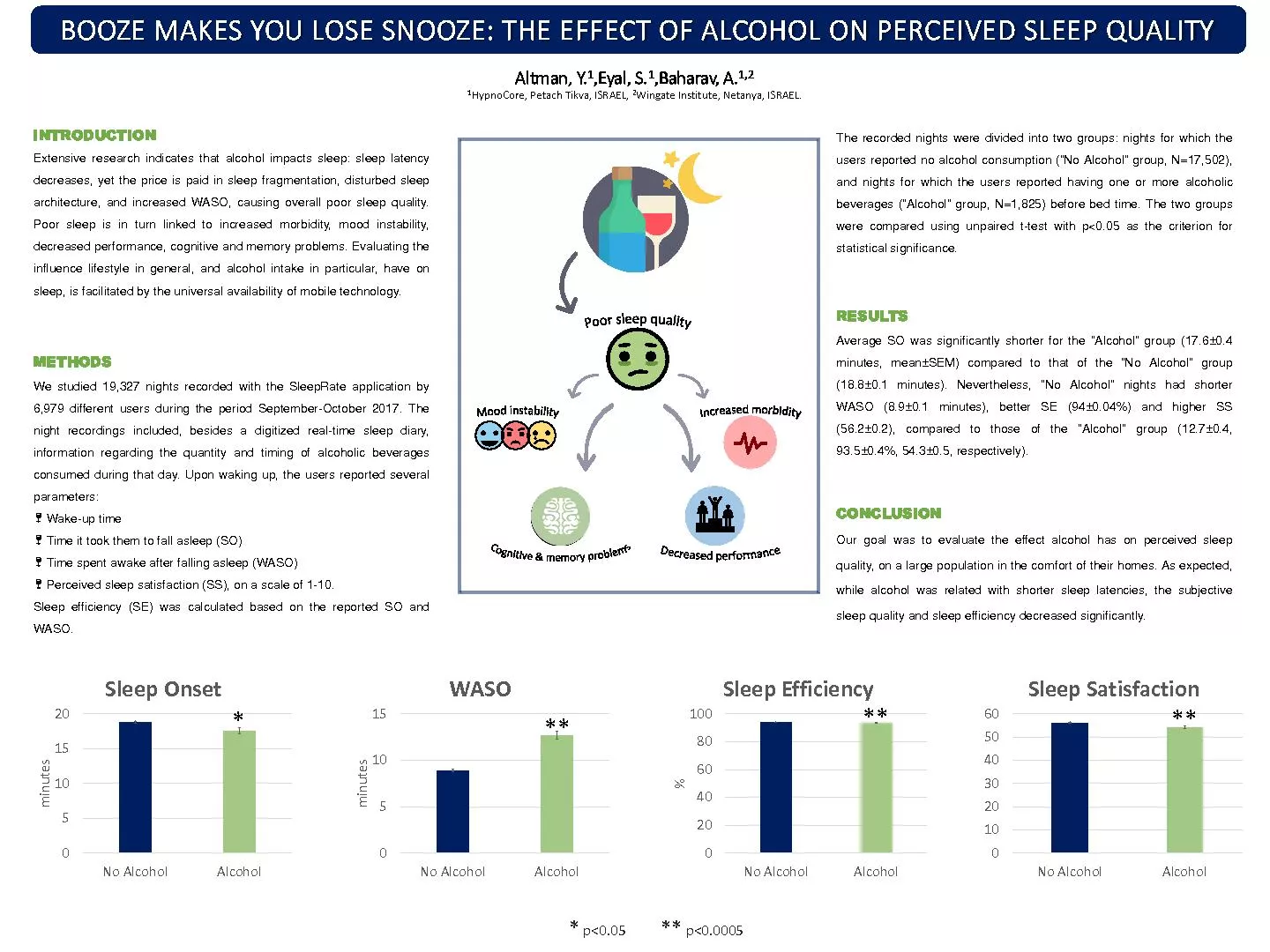

Extensive research indicates that alcohol impacts sleep sleep latency decreases yet the price is paid in sleep fragmentation disturbed sleep architecture and increased WASO causing overall poor ID: 827581
Download Pdf The PPT/PDF document "INTRODUCTION" is the property of its rightful owner. Permission is granted to download and print the materials on this web site for personal, non-commercial use only, and to display it on your personal computer provided you do not modify the materials and that you retain all copyright notices contained in the materials. By downloading content from our website, you accept the terms of this agreement.
INTRODUCTIONExtensiveresearchindicate
INTRODUCTIONExtensiveresearchindicatesthatalcoholimpactssleep:sleeplatencydecreases,yetthepriceispaidinsleepfragmentation,disturbedsleeparchitecture,andincreasedWASO,causingoverallpoorsleepquality.Poorsleepisinturnlinkedtoincreasedmorbidity,moodinstability,decreasedperformance,cognitiveandmemoryproblems.Evaluatingtheinfluencelifestyleingeneral,andalcoholintakeinparticular,haveonsleep,isfacilitatedbytheuniversalavailabilityofmobiletechnology.METHODSWestudied19,327nightsrecordedwiththeSleepRateapplicationby6,979differentusersduringtheperiodSeptember-October2017.Thenightrecordingsincluded,besidesadigitizedreal-timesleepdiary,informationregardingthequantityandtimingofalcoholicbeveragesconsumedduringthatday.Uponwakingup,theusersreportedseveralparameters:Wake-uptimeTimeittookthemtofallasleep(SO)Timespentawakeafterfallingasleep(WASO)Perceivedsleepsatisfaction(SS),onascaleof1-10.Sleepefficiency(SE)wascalculatedbasedonthereportedSOandWASO.Therecordednightsweredividedintotwogroups:nightsforwhichtheusersreportednoalcoholconsumption(âNoAlcoholâgroup,N=17,502),andnightsforwhichtheusersreportedhavingoneormorealcoholicbeverages(âAlcoholâgroup,N=1,825)beforebedtime.Thetwogroupswerecomparedusingunpairedt-testwithp0.05asthecriterionforstatisticalsignificance.RESULTSAverageSOwassignificantlyshorterfortheâAlcoholâgroup(17.6±0.4minutes,mean±SEM)comparedtothatoftheâNoAlcoholâgroup(18.8±0.1minutes).Nevertheless,âNoAlcoholânightshadshorterWASO(8.9±0.1minutes),betterSE(94±0.04%)andhigherSS(56.2±0.2),comparedtothoseoftheâAlcoholâgroup(12.7±0.4,93.5±0.4%,54.3±0.5,respectively).CONCLUSIONOurgoalwastoevaluatetheeffectalcoholhasonperceivedsleepquality,onalargepopulationinthecomfortoftheirhomes.Asexpected,whilealcoholwasrelatedwithshortersleeplatencies,thesubjectivesleepqualityandsleepefficiencydecreasedsignificantly.Altman, Y.1,Eyal, S.1,Baharav, A.1,21HypnoCore, PetachTikva, ISRAEL, 2Wingate Institute, Netanya, ISRAEL. BOOZE MAKES YOU LOSE SNOOZE: THE EFFECT OF ALCOHOL ON PERCEIVED SLEEP QUALITY05101520No AlcoholAlcoholminutesSleep Onset*051015No AlcoholAlcoholminutesWASO**0102030405060No AlcoholAlcoholSleep Satisfaction**020406080100No AlcoholAlcohol%Sleep Efficiency****p0.0005*p0.05